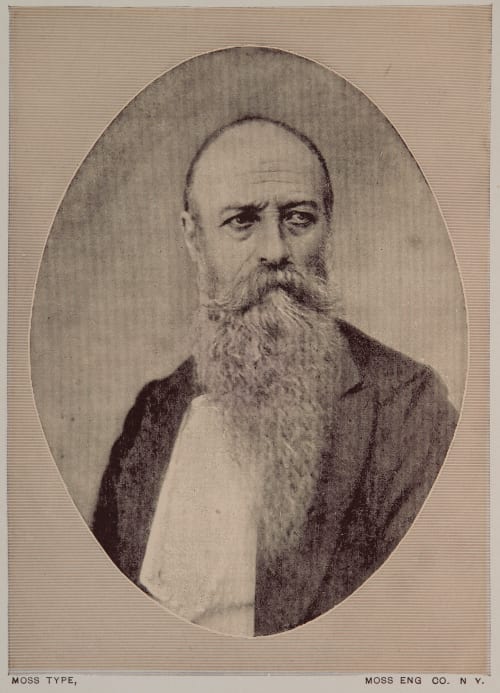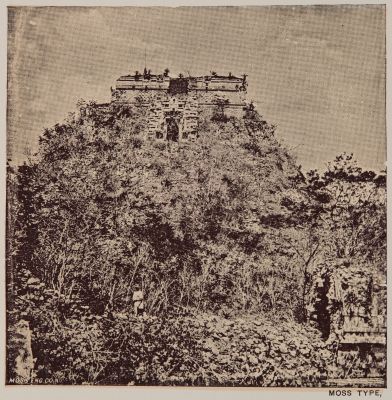
Title
FrontisArtist
Le Plongeon, Augustus (American, 1826-1908)Publication
Sacred Mysteries Among the Mayas and the QuichesDate
1886Process
Halftone (Moss-type)Image Size
12.5 x 9 cm
…one of the earliest half-tone books in the United States. John Moss’s method of half-tone was a secret one and was not patented.
John Calvin Moss (1838—1892) was an American inventor credited with developing the first practicable photo-engraving process in 1863. His work, and that of others such as William Leggo in Canada led to a revolution in printing and eventually to the mass marketing around the world of newspapers and magazines and books which combined photographs with traditional text.
In brief his method was this: Plate glass was coated with a rather thick film of sensitized gelatin. After long exposure to light under an intense negative the gelatin was soaked in water, when the unacted-on portions swelled, and while in this state a plaster or wax cast was taken from the gelatin relief. A plaster mold was made from this plaster cast, and finally a cast in stereotype metal from the plaster mold. [1]
The short-lived company created to use the process was the Actinic Engraving Co. about 1872. One important adjunct to his method was how he created reduced copies of art from photographs. To start a large photographic print was made. Over this an artist would draw a line copy in India ink. The photographic image would then be bleached out and from the resulting line art a reduced high contrast photographic copy would be made to produce the printing plate. Moss then became associated with the Photo Engraving Co., but eventually opened his own business. He then developed the “Moss-type” a single line screen Halftone method in 1885. Both were secret processes. Hanson Collection catalog, p. 88.
Moss’ process was enhanced over the years by continuing innovations such as Frederick E. Ives’ invention in 1886 of half-tone engraving for newspaper photographs. [2]
Augustus Le Plongeon was a French-American photographer, archeologist, antiquarian and author who studied the pre-Columbian ruins of America, particularly those of the Maya civilization on the northern Yucatán Peninsula. His partner and wife, Alice Dixon the daughter of Henry Dixon, a copper-plate printer who later became a successful photographer. Henry Dixon was recognized in the late nineteenth century for his contribution to the development of panchromatic photography and for his photos of London architecture taken for the Society for Photographing Relics of Old London. Alice learned the principles of photography from her father and worked as an assistant at his studio. In 1871, Alice met Augustus Le Plongeon while he was in London studying Mexican and Maya artifacts at the British Museum. After she first met Augustus, Alice told her mother, "Mother, while I was out today I met him who I know that I shall have to marry by and by." Twenty-five years her senior, Augustus Le Plongeon was a French-American photographer and amateur archeologist who had already traveled and worked in Chile, California, and Peru. He was in London to prepare for a trip into the jungles of Yucatán. Alice grew interested in ancient Maya civilization, studied John L. Stephen’s Incidents of Travel in Yucatan, and agreed to join Augustus on his expedition. Alice and Augustus, not yet married, traveled from London to New York to complete the last of their preparations. [3]
References
[1] Hanson, David Checklist of photomechanical processes and printing 1825-1910, 2017
[2] wikipedia.org/wiki/John_C._Moss
[3] wikipedia.org/wiki/Augustus_Le_Plongeon

